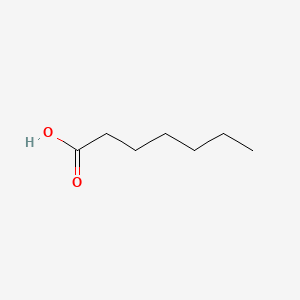| MeSH term | MeSH ID | Detail |
|---|---|---|
| Olfaction Disorders | D000857 | 17 associated lipids |
| Byssinosis | D002095 | 11 associated lipids |
| Mitochondrial Diseases | D028361 | 25 associated lipids |
HEPTANOIC ACID
HEPTANOIC ACID is a lipid of Fatty Acyls (FA) class. Heptanoic acid is associated with abnormalities such as Dehydration. The involved functions are known as Process, Anabolism, inhibitors, Oxidation and fatty acid oxidation. The related lipids are Heptanoates and undecanoic acid.
Cross Reference
Introduction
To understand associated biological information of HEPTANOIC ACID, we collected biological information of abnormalities, associated pathways, cellular/molecular locations, biological functions, related genes/proteins, lipids and common seen animal/experimental models with organized paragraphs from literatures.
What diseases are associated with HEPTANOIC ACID?
HEPTANOIC ACID is suspected in Dehydration and other diseases in descending order of the highest number of associated sentences.
Related references are mostly published in these journals:
| Disease | Cross reference | Weighted score | Related literature |
|---|
Possible diseases from mapped MeSH terms on references
We collected disease MeSH terms mapped to the references associated with HEPTANOIC ACID
PubChem Associated disorders and diseases
What pathways are associated with HEPTANOIC ACID
There are no associated biomedical information in the current reference collection.
PubChem Biomolecular Interactions and Pathways
Link to PubChem Biomolecular Interactions and PathwaysWhat cellular locations are associated with HEPTANOIC ACID?
There are no associated biomedical information in the current reference collection.
What functions are associated with HEPTANOIC ACID?
Related references are published most in these journals:
| Function | Cross reference | Weighted score | Related literatures |
|---|
What lipids are associated with HEPTANOIC ACID?
Related references are published most in these journals:
| Lipid concept | Cross reference | Weighted score | Related literatures |
|---|
What genes are associated with HEPTANOIC ACID?
There are no associated biomedical information in the current reference collection.
What common seen animal models are associated with HEPTANOIC ACID?
There are no associated biomedical information in the current reference collection.
NCBI Entrez Crosslinks
All references with HEPTANOIC ACID
Download all related citations| Authors | Title | Published | Journal | PubMed Link |
|---|---|---|---|---|
| Taratula O et al. | Binding studies of molecular linkers to ZnO and MgZnO nanotip films. | 2006 | J Phys Chem B | pmid:16570948 |
| Liu KS et al. | Novel depots of buprenorphine prodrugs have a long-acting antinociceptive effect. | 2006 | Anesth. Analg. | pmid:16632824 |
| Rushdi AI and Simoneit BR | Abiotic condensation synthesis of glyceride lipids and wax esters under simulated hydrothermal conditions. | 2006 | Orig Life Evol Biosph | pmid:16642268 |
| Hero M et al. | Treatment with the aromatase inhibitor letrozole during adolescence increases near-final height in boys with constitutional delay of puberty. | 2006 | Clin. Endocrinol. (Oxf) | pmid:16649968 |
| Kinman RP et al. | Parenteral and enteral metabolism of anaplerotic triheptanoin in normal rats. | 2006 | Am. J. Physiol. Endocrinol. Metab. | pmid:16705058 |
| Vitali M et al. | Exposure to organic solvents among handicraft car painters: A pilot study in Italy. | 2006 | Ind Health | pmid:16716010 |
| Al-Fadhli A et al. | Glycolipids from the red alga Chondria armata (Kutz.) Okamura. | 2006 | Glycobiology | pmid:16799167 |
| Seidman SN and Roose SP | The sexual effects of testosterone replacement in depressed men: randomized, placebo-controlled clinical trial. | 2006 May-Jun | J Sex Marital Ther | pmid:16809253 |
| Orzechowska GE et al. | Photochemical sources of organic acids. 2. Formation of C5-C9 carboxylic acids from alkene ozonolysis under dry and humid conditions. | 2005 | J Phys Chem A | pmid:16839061 |
| Kaler G et al. | Olfactory mucosa-expressed organic anion transporter, Oat6, manifests high affinity interactions with odorant organic anions. | 2006 | Biochem. Biophys. Res. Commun. | pmid:17094945 |
